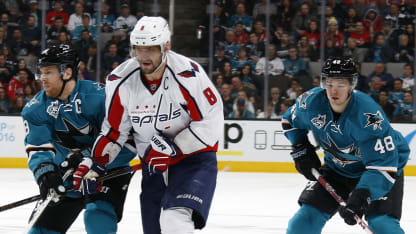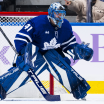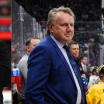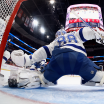Power-play points became scarce last season, so it's all the more important for fantasy owners to prioritize players in position to thrive or improve in those prime situations.
Four players had 30 or more power-play points last season after nine players eclipsed the mark in 2014-15. The most productive fantasy power-play point pairs can range from multiple forwards, a forward-defenseman combination, or two defensemen who skate together on their team's first unit.
Fantasy: First power-play units to watch in drafts
Capitals, Sharks, Stars among best; Predators, Panthers improved

© Don Smith/Getty Images
Many of the NHL's best first power-play units involve players who will be drafted in early rounds on average in fantasy drafts. Finding corresponding man-advantage commodities in middle or late rounds is much more challenging.
Being aware of a team's most frequent first-unit power-play personnel from last season, along with player track records and offseason lineup trends, can help identify which power-play running mates are worth targeting together in drafts. Here are 10 of the most promising power-play units that warrant collective fantasy consideration based on past production and future potential.
CREAM OF THE CROP
Washington Capitals
The Capitals have had the most power-play staying power in the League, finishing among the top five in conversion percentage each of the past four seasons. Last season, their top unit was comprised of usual suspects Alex Ovechkin (led NHL with 19 PPG) and Nicklas Backstrom (30 PPP; most since 2013-14), along with defenseman John Carlson and forwards T.J. Oshie and Marcus Johansson. Defenseman Matt Niskanen was one of the most productive power-play defensemen during Carlson's injury absence. If you don't get the chance to draft Ovechkin in the first round, Backstrom should be available in the late-second/early-third round and Carlson a round or two later. That combination could be lethal fantasy-wise if Carlson stays healthy. A wild card for the Capitals is breakout star Evgeni Kuznetsov, who could eventually play on Ovechkin's wing at even strength or join this successful first unit on a full-time basis in the near future.
San Jose Sharks
Any opportunity to get a piece of the Sharks' first power-play unit should be seized by fantasy owners. The vaunted quintet of forwards Joe Thornton, Joe Pavelski, Logan Couture, Patrick Marleau and high-scoring defenseman Brent Burns helped the Sharks finish third in the regular season in power-play conversion percentage (22.5) and thrive in the Stanley Cup Playoffs (24.0) thanks to Couture's surge (11 postseason PPP). You likely will have to spend a first-round pick to get Pavelski or Burns, and then a second-rounder to get Thornton, but landing one of the three and then grabbing Couture in the third round is a more convenient strategy because of their collective power-play chemistry. Marleau (25 PPP last season) and free-agent signee Mikkel Boedker (19 PPP) are the top candidates to round out the Sharks' first unit this season and should each be available after the 13th round.
Dallas Stars
The Stars had the highest scoring offense in the League last season (3.23 goals per game), and their power play jumping from tied for eighth in 2014-15 (19.3 percent) to fourth (22.1) was a huge reason. It's nearly impossible to draft Jamie Benn and Tyler Seguin together with each projected to be a first-round fantasy pick, but it's worth drafting either forward if possible and stacking him with consistent center Jason Spezza in the fifth or sixth round or the always-dangerous Patrick Sharp even later. Benn and Spezza did not play much together at even-strength but finished tied for the fourth most productive power-play point pair (17 team goals with each recording a point). Drafting any of these forwards together with defenseman John Klingberg is also a worthwhile strategy. Klingberg finished fifth among defensemen in points (58) with 22 on the power play.
Chicago Blackhawks
The best forward-defenseman power-play combination last season was Patrick Kane and Brent Seabrook (19 team power-play goals with each earning a point). The Blackhawks also rolled out Duncan Keith and Artemi Panarin on their first unit, with Jonathan Toews often skating with the second group. Kane and Panarin were the best point pair in the League last season, and the fact that they skated together at even strength and on the power play padded their totals. Keith, ranked 72nd in NHL.com's offseason top 200 rankings, finished 138th overall in Yahoo's performance-based rankings last season but remains a top-15 defenseman considering he missed time with an injury. Seabrook finished as the 13th most-valuable defenseman in standard leagues last season but still could be available outside the top 100. Whether or not you draft Kane or Panarin early, Chicago's scoring defensemen remain undervalued fantasy-wise because of their power-play contributions.
STILL DANGEROUS
Philadelphia Flyers
The Flyers made the playoffs after an up-and-down season that saw their power-play efficiency drop to 18.9 percent (tied for 11th) after finishing in the top five in each of the past two seasons. Forward Jakub Voracek was moved off the first line with Claude Giroux in favor of Wayne Simmonds and Brayden Schenn, and Voracek's fantasy value plummeted as a result. But all four forwards remained together on the power play, which got an in-season spark by rookie Shayne Gostisbehere (46 points, 22 PPP in 64 games). If Gostisbehere plays a full season anchoring Giroux and Co. with the man advantage, he has potential to finish among the top 10 fantasy defensemen and the League leaders in PPP (he finished tied for 11th last season). Drafting Giroux in the second round and Gostisbehere in the fourth or fifth would have a similar ceiling to any of the elite forward-defensemen scoring combos in the game with less risk.
Pittsburgh Penguins
The Penguins had early growing pains offensively last season, but clicked after a midseason coaching change and put together a stunning Stanley Cup championship run. Their power-play efficiency was pedestrian (18.4 percent, 16th in NHL), but they were better once coach Mike Sullivan took over in the regular season (20 percent) and postseason (23.4). Expect them to be back in the top 10 next season sporting a first unit that includes Sidney Crosby, Evgeni Malkin, Kris Letang, Phil Kessel and Patric Hornqvist. Crosby and Malkin lead the NHL in PPP per game among players with a minimum 500 games played since 2005-06 (per the Elias Sports Bureau) and fantasy owners can expect them to take advantage of their time together considering they and Kessel played on three separate lines at even strength in the playoffs. It will be tough to draft Crosby (No. 2 in NHL.com's rankings) along with Malkin or Letang, but drafting Kessel in the second or third round or Hornqvist in the middle rounds could pay sizable dividends. Crosby, who finished third League-wide in points last season, played on the same line as Hornqvist at even strength for much of the year and that duo also shared power-play ice time, making them a targetable combination.
Tampa Bay Lightning
It was shocking to see the Lightning finish as low as they did in the power-play realm last season (15.8 percent; tied for third-worst in NHL), but consider this an opportunity to pounce on positive regression entering this fantasy season. Jonathan Drouin, 21, had six PPP in 17 postseason games and has a chance to nail down a first-unit spot alongside Steven Stamkos, Nikita Kucherov, Tyler Johnson and either defenseman Victor Hedman or Anton Stralman. Johnson missed time last season and was a fantasy disappointment even when healthy in the regular season, but a strong playoff showing and an offseason to recover should help the young Lightning get back to their full potential. There was a big drop-off after Kucherov (25 PPP) and Stamkos (23) on their team power-play leaderboard, with Johnson (13) and Stralman (12) far behind. Tampa Bay may still split power-play duties among its top two defensemen, but drafting Stamkos or Kucherov in the late-first/early-second round and then prioritizing Drouin in middle rounds as a breakout candidate is a safe approach.
MOST IMPROVED
Nashville Predators
The Predators had the most productive power-play point pair involving two defensemen last season with Roman Josi and Shea Weber (17 PPG with each earning a point), finishing 10th in the League in efficiency (19.7 percent). Now, after trading Weber for P.K. Subban, the ceiling is even higher. Subban has the most power-play points (94) among players with 'D' eligibility in Yahoo since 2012-13, and joins a first unit that featured Ryan Johansen, James Neal and Josi most frequently in the playoffs and also has Filip Forsberg, who formed Nashville's second-best regular-season power-play point pair with Weber (14 PPG with each earning a point). If you are able to take Subban late in the first round, it's worth prioritizing Forsberg, a tri-eligible forward, in the third or fourth round or Neal in the fourth or fifth. Subban has a chance to put forth 25-30 PPP with better standard-league category coverage than any other defenseman, and Neal and Forsberg will produce in at least five of the six categories with possible power-play production spikes. Neal likely will be attainable later than Forsberg, and had 30 PPP in 2011-12 and 26 in 2013-14 with the Penguins alongside Malkin and Crosby, so his potential for across-the-board coverage and elite power-play production is real. It's also an intriguing strategy to take Subban in the first round and Josi in the fourth or fifth if you want to go all-in on what could be the best scoring defensemen duo in more than a decade.
Buffalo Sabres
Despite missing the playoffs last season, the Sabres had a strong power play which finished tied for 11th in efficiency (18.9 percent). Their first unit featured forwards Jack Eichel and Ryan O'Reilly, and defenseman Rasmus Ristolainen, with other rotating forwards including Jamie McGinn (prior to being traded to the Anaheim Ducks), Sam Reinhart, Evander Kane and Matt Moulson. Now, the picture becomes clearer with the addition of Kyle Okposo, who is used to prowling the New York Islanders' first unit alongside John Tavares. It remains to be seen whether Okposo will flank Eichel or O'Reilly at even strength, but you can bet that the three forwards will be collaborating on Buffalo's first power-play unit, one that looks dangerous on paper. Okposo has topped 20 PPP twice in his career, and has had a rising category total in recent seasons (15 in 2013-14; 18 in 2014-15; 23 in 2015-16). Many of the possible power-play combinations on this list require you to spend early-round picks, but drafting Eichel or O'Reilly in the fourth or fifth round, along with Okposo in the sixth or seventh and then Ristolainen inside the top 100 overall, presents sneaky combinations with upside.
Florida Panthers
NHL.com's Ben Zweiman featured Jonathan Huberdeau and Aleksander Barkov as a
fantasy point pair on the rise
, and the combinations are indeed endless from a power-play standpoint after the Panthers added specialist Keith Yandle. Barkov, who had 59 points (16 PPP) in 66 games alongside Huberdeau and Jaromir Jagr last season, could be one of the biggest draft bargains among players inside the top 100. Yandle should be there to stack in the 60-75 range after Barkov. Drafting the best player available for the first four or five rounds and then stacking Barkov or Huberdeau with Yandle in consecutive rounds could be a major haul if the Panthers' power-play improves on its 16.9 conversion percentage from last season (23rd in NHL). It would also be interesting to consider drafting Yandle in his range and then Aaron Ekblad outside the top 100 overall hoping the two defensemen find chemistry together on the first power-play unit.

















